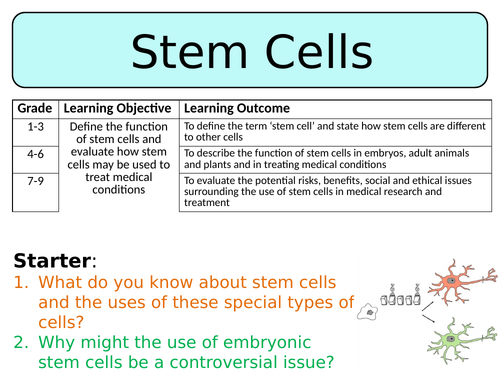
This lesson is designed to meet specification points for the new AQA GCSE Trilogy Biology ‘Cells’ SoW.
For more resources designed to meet specification points for the new AQA GCSE Trilogy Biology, Chemistry and Physics specifications please visit my shop: https://www.tes.com/teaching-resources/shop/SWiftScience
This lesson begins by pupils being introduced to the idea of stem cells, what they are and why they are important. Pupils will then watch a video about stem cells, the difference between adult and embryonic stem cells and their importance in medical research and treatments. Pupils will answer questions whilst watching the video and can self-assess their work using the answers provided once it has finished.
Pupils will then need to summarise what they have learnt so far by completing a fill-in-the-blank task, this can be copied off the board or summarised in their book.
The next activity is on stem cells in plants, pupils will be given some information on the board and will then need to answer questions about this information.
The next activity will focus on the social, moral and ethical implications of using stem cells for medical research purposes. Pupils will need to read opinion/fact cards about the use of stem cells and firstly will need to discuss the pros and cons of using stem cells for medical research. The second task is for pupils to sort the information cards into ‘fact’ or ‘opinion’ columns - this can be self-assessed using the answers provided.
The final plenary task is an exam-style question about use of stem cells, pupils can then self-assess their work.
Get this resource as part of a bundle and save up to 53%
A bundle is a package of resources grouped together to teach a particular topic, or a series of lessons, in one place.
Something went wrong, please try again later.
Fabulous, I can always count on your resources to save me time and effort. Minimal adaptation required. I really like the self assessment included.
Report this resourceto let us know if it violates our terms and conditions.
Our customer service team will review your report and will be in touch.
